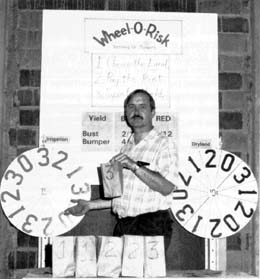Fall 1993 // Volume 31 // Number 3 // Ideas at Work // 3IAW6
Wheel-O-Risk: Farming for Peanuts
Abstract
The "Wheel-O-Risk" display was designed and used to introduce urban residents to risk and decision making in agriculture. Playing the Wheel-O-Risk is a long way from being a real farm decision maker, but like the activities of petting a lamb or pig, this exercise in risky decision making can be educational and entertaining for nonfarm audiences.
Bringing urban residents to a rural farm is a valuable educational experience for them and a common activity in many Extension agricultural programs. Farm visitors pet the animals and learn about production agriculture. But, what kind of activity can represent the decisions and calculated risks related to weather, prices, livestock diseases, and government policies faced by U.S. farmers?
The "Wheel-O-Risk" display was designed and used to introduce urban residents to risk and decision making in agriculture. The Wheel-O-Risk gave farm visitors the chance to farm for "planting costs" of only 10 or 15 cents. The 10-cent wheel represented the opportunity to rent poorer ground while the 15-cent wheel represented the increased costs of farming better soil. Payoffs were in scoops (ounces) of unshelled peanuts, marked on each wheel. Participants were asked to: choose the wheel they wanted to play, pay the price, and spin for the "yield." People supervising the display used farming terms such as yield, weather, and harvest to make the role playing as real as possible.
More than 250 visitors played the game, consumed 30 pounds of peanuts (on site) and spent nearly $35. When the display was used a second time, sunflower seeds were the "crop" and more than 200 people played "Farming for Flowers."
A small brown paper bag held each harvest. To avoid harsh feelings and potential problems with state gambling commissioners, people who spun the wheel and came up with a zero were given three or four peanuts (8-10 sunflower seeds) and told that the "handout" was a government disaster payment. Profits went to a local charity.
When parents with young children played the game, they were asked to play the role of farm lender and farmer, respectively. Parents were told the banker needs to understand agricultural risks as well as the producer. The lenders (adults) were often repaid by the farmers (children) with small portions of their crop.

The display was constructed from three-eighths inch plywood and bolted to two upright fence posts. Nylon bushings in the two- foot wheels were fastened to the four-foot square backdrop using carriage bolts. Finish nails on the wheels and a plastic tab above each wheel, provided a positive stopping point. A smaller version of the display could be designed for increased portability. Display costs were less than $30, excluding labor.
Playing the Wheel-O-Risk is a long way from being a real farm decision maker, but like the activities of petting a lamb or pig, this exercise in risky decision making can be educational and entertaining for nonfarm audiences. Wheel-O-Risk display.
